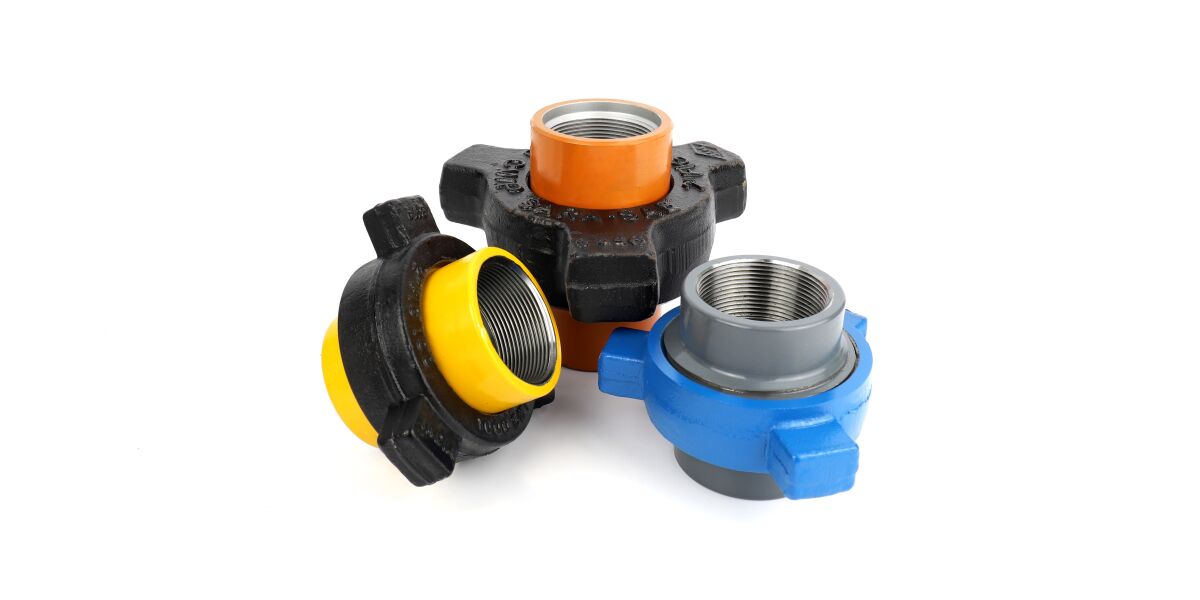Can't find what you're looking for?

Give us a call or mail us for professional product advice.
Why Wilson & Wilson Couplings?
- No hidden/additional costs:
VAT, customs or import duties - Easily ordered, fast delivery (3-5 working days)
- Free shipping from £ 50,-
(below: £ 12,95)
Hammer Union
Read more

Hammer Union Fig. 206 BSP Female Thread Stainless Steel with O-ring Gasket
Hammer unions are mechanical fittings that connect segments of piping or tubing using threads and seal rings. The unique feature of these couplings is their ease of assembly and disassembly, which makes them ideal for applications requiring quick and frequent connections.
Hammer unions typically consist of three parts:
- Male part
- Female part
- Hammer nut
The coupling is assembled by threading the male and female subs together and tightening the connection with the hammer nut. The "hammer" in the name refers to the use of a sledgehammer or mallet to tighten or loosen the connection, ensuring a strong and leak-free joint.
There are several types of hammer unions, each designed for specific applications. The main difference between them lies in their pressure rating and design. Below are some of the most common types:
Fig. 100 Hammer Union (Low-Pressure Applications)
- Working Pressure: 1,00 PSI / 69 BAR
- Colour: Black (nut), yellow (subs)
- These unions are used for low-pressure applications, such as the conveyance of water, oil, or gas in flow lines. Figure 100 unions are typically equipped with a rubber seal for leak prevention.
Fig. 200 Hammer Union
- Working Pressure: 2000 PSI / 138 BAR
- Colour: Blue (nut), dark grey (subs)
- Suitable for low to medium-pressure applications, the Figure 200 hammer union is commonly found in pipelines used for air, water, oil, or steam service.
Fig. 206 Hammer Union
- Working Pressure: 2,000 PSI / 138 BAR
- Colour: Blue (nut), grey (subs)
- These unions are similar to Figure 200 but have a different design, providing an alternative for medium-pressure applications, particularly where compatibility with Figure 200 unions is needed.
Fig. 400 Hammer Union
- Working Pressure: 4,000 PSI / 276 BAR
- Color: Black (nut), Red (subs)
- Designed for high-pressure applications, this union is ideal for cementing, fracturing, and wellhead equipment. The Figure 400 is widely used in the oil and gas industry, thanks to its durability and strong seal.
Fig. 602 Hammer Union
- Working Pressure: 6000 PSI / 414 BAR
- Colour: Black (nut), Orange (subs)
- These unions are ideal for mud lines, manifold lines, and high-pressure oil or gas lines. Figure 600 unions feature high-strength alloy steel and are built to withstand substantial pressure while maintaining a secure seal.
Fig. 1002 Hammer Union
- Working Pressure: 10,000 PSI / 690 BAR
- Colour: Red (nut), Blue (subs)
- Built for extreme pressure conditions, Figure 1002 unions are often used in fracturing, cementing, and acidizing. The O-ring in the union ensures a strong seal, even under high pressures.
Fig. 1502 Hammer Union
- Working Pressure: 15,000 PSI / 1034 BAR
- Colour: Blue (nut), Red (subs)
- This type is designed for ultra-high pressure applications, such as well servicing, cementing, and high-pressure fracturing jobs. The Figure 1502 union is known for its reliability in the most demanding environments.
We are able to supply all variations in the diagram below. Please contact our sales team if the coupling you need is not on our website.

